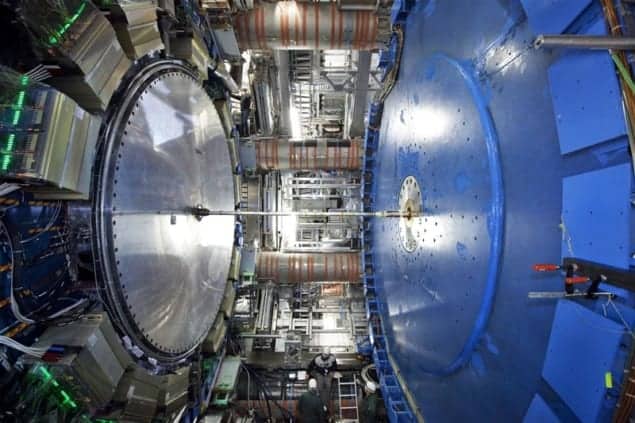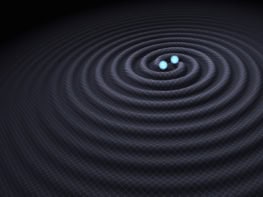Particle physicists start the new year with a mild dose of empirical medicine, as the LHC closes in on models of extra dimensions and supersymmetry

If January blues are getting the better of you, cast your mind back to the summer of 2008 when speculation about potential discoveries at CERN’s Large Hadron Collider (LHC), which was then about to switch on, went into overdrive. The world’s media descended into a frenzy about what the LHC might cook up: new dimensions of space, “sparticles”, dark matter and – who could forget? – planet-eating black holes. Two and a half years later and – no surprise, really – planet Earth prevails. Yet so does our well-established picture of the fundamental workings of nature.
It is still early days at the LHC, but the 27 km-circumference machine’s first year of smashing protons into each other at record energies is beginning to tame theorists’ imaginations. Researchers on the Compact Muon Solenoid (CMS) experiment, for example, have reported that, at the energies probed so far, quarks do not exhibit substructure (arXiv:1010.4439), exotic particles such as colorons and E6 diquarks have not shown up (arXiv:1010.0203) – and nor have leptoquarks (arXiv:1012.4031) or new heavy gauge bosons (arXiv:1012.5945) either. Although these entities cannot be ruled out completely, LHC data have allowed them less room to hide – principally by allowing researchers to place stringent limits on the particles’ masses.
CMS scientists have also found no evidence for micro black holes in their 12,500 tonne detector (arXiv:1012.3375). This result, reported just before Christmas, will not have come as a shock to anyone who thinks such black holes will destroy the planet. (For them, it’s only a matter of time…) But it has not surprised many physicists either, given that miniature black holes could only appear at the LHC if space has more than three dimensions. So what does CMS’s black-hole blank mean for such outlandish pictures of space–time? Can we now simply start ruling them out?
“The fascinating science of black-hole production and evaporation still stands,” insists Steve Giddings of the University of California, Santa Barbara, who a decade ago co-proposed the possibility that the LHC might create black holes. “The CMS results begin to rule out the most extreme configurations of extra dimensions, although it is true that such configurations are believed unlikely by many. It’s still a possibility that black holes will be made at the LHC, but it’s not a prediction unless you know the configuration of the extra dimensions!”
Bridging the gap
The models of extra dimensions that underpin the black-hole prediction were originally proposed in 1998 by Nima Arkani-Hamed of the Institute for Advanced Study in Princeton and others to address what is known as the “hierarchy problem”: why gravity is more than 30 orders of magnitude weaker than the forces that govern the quantum world. They posit that everything bar gravity is confined to a 3D brane that exists in a higher-dimensional space from which the true strength of gravity leaks, reducing the Planck scale (at which gravity and the other forces have similar strengths, as is thought to have been the case in the first instants of the universe) from its conventional value of 1016 TeV to just a few TeV – exactly the energy the LHC is exploring.
The fascinating science of black-hole production and evaporation still stands Steve Giddings, University of California, Santa Barbara
In such a higher-dimensional universe, argue Giddings and others, micro black holes could be squeezed into existence at the rate of one per second at the LHC by particles encountering the true strength of gravity at short distances – before decaying almost instantaneously into a flash of regular particles. However, Arkani-Hamed says that he never thought the black-hole signal was plausible. “Even if extra dimensions exist, black holes would be the last thing you’d discover because you’d see other, larger effects at lower energies first, such as gravitational radiation into the extra dimensions,” he says. “Whatever the reduced Planck scale is, you would have to go to energies several times that to start making what you would recognize as a black hole.”
But Georgi Dvali of Ludwig-Maximilians Universität in Munich, Germany, who worked with Arkani-Hamed on large-extra-dimension models, insists that micro black holes do exist. “It follows from the existence of big black holes,” he told physicsworld.com. “A micro black hole is just what happens to a big one at the very last stage of evolution once it has all but evaporated via Hawking radiation. We know this should happen – we just don’t know at what length [i.e. energy] scale.”
The problem, Dvali points out, is that our current theoretical understanding of micro black holes is not sufficient to accurately predict their properties. To search for these (and other exotic entities) at the LHC, researchers have to model the background events that could mimic them, mostly involving copious jets formed by quarks and gluons – a process that itself is not precisely known theoretically. So far the CMS team has found no signal against this background, allowing researchers to exclude black holes with minimum masses of 3.5–4.5 TeV/c2.
A blow for string theory?
But is the lack of black holes seen by the CMS a setback for string theory? After all, this vast theoretical framework also invokes extra dimensions to connect gravity with the other three forces, describing elementary particles as facets of fundamental strings vibrating in a compact 6D or 7D space. However, Arkani-Hamed, for one, rejects the notion that string theory has been given a bloody nose, describing any such claim as “ridiculous”.
Lisa Randall of Harvard University, who in 1999 co-developed a similar extra-dimensional approach called “warped geometries” to address the hierarchy problem, explains that both hers and Arkani-Hamed’s large-extra-dimension (LED) models use string-theory ingredients and might even be derived from string theory, but that neither implies the other. “Ours are really effective theories that are defined at low energies,” she says. “These models don’t necessarily originate in string theory, and string theory doesn’t necessarily imply this low-energy realization.”
In fact, string theory illustrates how hard it can be to test mathematics linking gravity to the quantum world. String theory describes an inordinate number of possible compactifications of the extra dimensions, each corresponding to a different possible universe, many of which contain features of both LED and warped-geometry models. “In this much broader class of ‘more realistic’ compactifications it appears possible to have particular ones where gravity gets strong at the LHC,” says Giddings. “But there may be many more where it doesn’t.”
Before theoretical physicists get a reputation for being disconnected from the realm of measurement, Arkani-Hamed points out that even before experiment renders an ultimate verdict, consistency conditions – mathematical ones as well as consistency with existing experiments – are so tough to satisfy that the vast majority of new ideas die immediately. Models of large extra dimensions, which were the first new attempt to crack the hierarchy problem in nearly 20 years, are plausible in part because experiments have only tested the sanctity of 3D space at the relatively gargantuan scale of about 0.1 mm.
Calling the super-world
One hotly anticipated find at the LHC would, however, boost string theory and solve the hierarchy problem at one fell swoop: supersymmetry (SUSY), which posits new quantum dimensions to space–time that give rise to a whole spectrum of heavy partners to the known Standard Model particles, dubbed “sparticles”. “Supersymmetry is a much deeper idea than extra dimensions, and there are also strong circumstantial hints that low-energy SUSY is correct,” says Arkani-Hamed. “So if I had to bet, I would bet (by a lot) that some variation of SUSY will show up at the LHC.”
Even if extra dimensions exist, black holes would be the last thing you’d discover Nima Arkani-Hamed, Institute for Advanced Study, Princeton
Searches for SUSY at previous CERN colliders and at the soon-to-be-shut-down Tevatron collider at Fermilab in the US have turned up nothing, allowing physicists to place lower limits on the sparticle masses. The LHC’s higher-energy collisions allow the machine to produce heavier sparticles, should they exist. But earlier this month CMS reported that it had found nothing new so far, ruling out supersymmetric particles with masses of less than about 0.5 TeV/c2 (arXiv:1101.1628). And in November the experiment reported no signs of long-lived supersymmetric gluons (gluinos), which should arise if a more recent take on SUSY called split-supersymmetry is correct (arXiv:1011.5861).
CMS’s sister experiment, ATLAS, is expected to report on its own searches for such exotic new particles in the next few weeks, although it has already ruled out quark sub-structure (arXiv:1009.5069) and exotic particles lighter than 1.26TeV/c2 (arXiv:1008.2461). And with the LHC due to restart next month after its winter shutdown and accumulate data at an even higher rate – perhaps also at a higher energy – decades of theoretical research into physics beyond the Standard Model (along with, of course, the mechanism that gives elementary particles their mass) will soon be put squarely on the line.
“Given that the LHC is just starting to dig into the territory relevant for the hierarchy problem, it’s hardly surprising that the machine isn’t turning up evidence for anything new in the very first analyses of the data collected at half its ultimate energy,” says Arkani-Hamed. “But even if no extra dimensions are found, that would be perfectly fine by me – after all, we’re in the truth business!”




